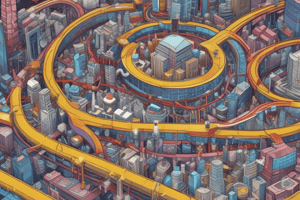Podcast
Questions and Answers
आर्थिक विकास दर के माध्यम से क्या मापा जाता है?
आर्थिक विकास दर के माध्यम से क्या मापा जाता है?
- कंपनियों और घरों का निर्धारण
- कर सर्वेक्षण
- निर्माण और सेवा की मांग (correct)
- सामग्री की प्रासंगिकता
मार्केट संरचना किस पर निर्भर होती है?
मार्केट संरचना किस पर निर्भर होती है?
- नौकरी की आपूर्ति
- कंपनियों की संख्या और आकार (correct)
- कर सर्वेक्षण
- सेवा की मांग
मूलभूत सिद्धांतों में से 'सप्लाई और मांग' क्या है?
मूलभूत सिद्धांतों में से 'सप्लाई और मांग' क्या है?
- उत्पादकों की मांग (correct)
- सामग्री की प्रासंगिकता
- कर
- महंगाई
'मनुष्य संसाधन' का क्या मतलब है?
'मनुष्य संसाधन' का क्या मतलब है?
किसको 'मुकुप' प्रकार कहा जाता है?
किसको 'मुकुप' प्रकार कहा जाता है?
'मूलभूत सिद्धांत' में से 'मूल्य-लचीलता' के प्रति उत्तर-प्रतिसाद किससे संबंधित है?
'मूलभूत सिद्धांत' में से 'मूल्य-लचीलता' के प्रति उत्तर-प्रतिसाद किससे संबंधित है?
मैक्रोइकोनॉमिक्स का मुख्य ध्यान किस विषय पर है?
मैक्रोइकोनॉमिक्स का मुख्य ध्यान किस विषय पर है?
GDP क्या मापता है?
GDP क्या मापता है?
महंगाई का मतलब क्या है?
महंगाई का मतलब क्या है?
बेरोजगारी किसे कहते हैं?
बेरोजगारी किसे कहते हैं?
समृद्धि का मतलब क्या है?
समृद्धि का मतलब क्या है?
Study Notes
Economy
The economy is a complex system involving various components that interact with one another to create growth, development, and wealth within a society. It is regulated by two main branches of economics: macroeconomics and microeconomics. Each branch focuses on different aspects of economic behavior and provides valuable insights into how the economy functions.
Macroeconomics
Macroeconomics studies the overall performance of the economy and its large-scale factors. This includes national income, employment levels, price indices, inflation rates, interest rates, exchange rates, and government fiscal policy. Key concepts in macroeconomics include:
Gross Domestic Product (GDP)
GDP measures the total value of all goods and services produced by a country's residents over a certain period. It serves as an indicator of a country's economic health and growth.
Inflation
Inflation refers to a sustained increase in the overall price level of goods and services in an economy. It is measured by the consumer price index (CPI) and is a key aspect of an economy's fiscal policy.
Unemployment
Unemployment is the percentage of the labor force that is out of work but actively seeking employment. It is a primary indicator of a country's economic health and can be affected by factors such as GDP, inflation, and government fiscal policies.
Economic Growth
Economic growth refers to the increase in the production of goods and services over time. It is measured by the GDP growth rate and can be influenced by factors such as technological advancements, investment, and government policies.
Microeconomics
Microeconomics focuses on individual economic units, such as households and firms, and their decision-making processes. This branch of economics includes the study of:
Supply and Demand
Supply and demand is a fundamental concept in economics that explains how the price of a good or service is determined by the relationship between the quantity of the good or service that producers want to sell and the quantity that consumers want to buy.
Market Structure
Market structure refers to the number and size of the firms in a market. The five main types of market structures are monopoly, monopolistic competition, oligopoly, monopsony, and perfect competition.
Price Elasticity of Demand
Price elasticity of demand measures how responsive the quantity demanded of a good or service is to changes in its price. Elastic goods exhibit high responsiveness, while inelastic goods exhibit low responsiveness.
Labor Markets
Labor markets involve the supply and demand for labor provided by firms and households. They determine wages and employment levels within an economy.
Resources
Resources play a crucial role in economics, both in macroeconomic and microeconomic contexts. There are two main types of resources:
Natural Resources
Natural resources include land, forests, water, minerals, coal, natural gas, and oil. These resources can be used as inputs into production processes and can also influence economic policies related to resource management and environmental sustainability.
Human Resources
Human resources refer to the individuals employed by organizations to produce goods and services. Human resources are essential in determining the economic output of an organization and must be managed effectively to achieve optimal performance.
In conclusion, the economy encompasses various aspects of society and business, including macroeconomics, microeconomics, and resources. By understanding these components and their relationships, we gain valuable insights into how economies function and develop over time.
Studying That Suits You
Use AI to generate personalized quizzes and flashcards to suit your learning preferences.
Description
Explore the fundamentals of macroeconomics, microeconomics, and the role of resources in the economy. Learn about key concepts such as GDP, inflation, supply and demand, market structure, natural resources, and human resources.




